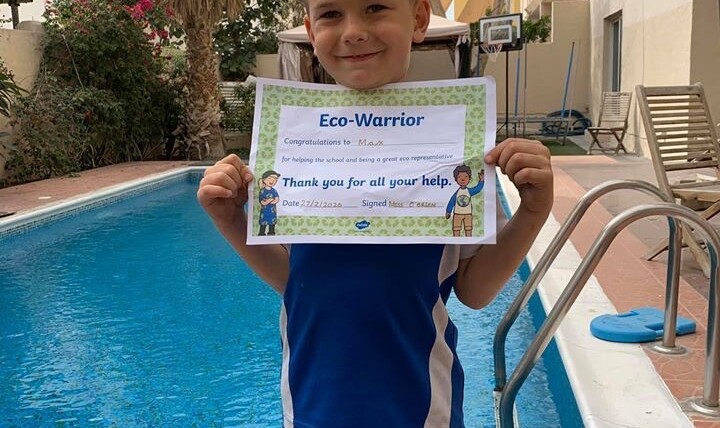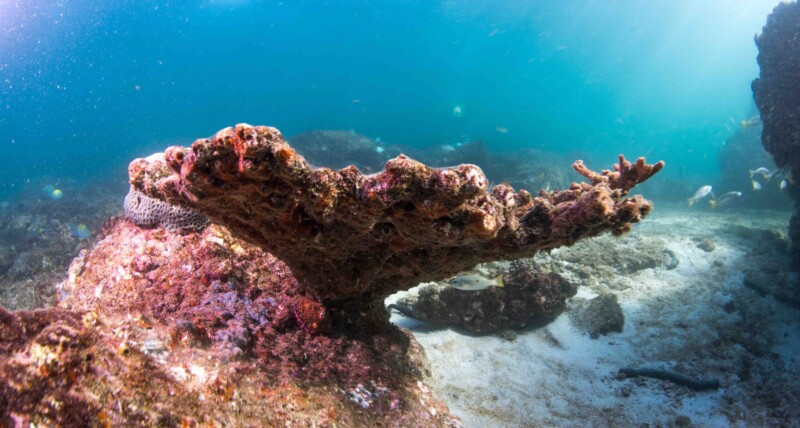April – June 2022
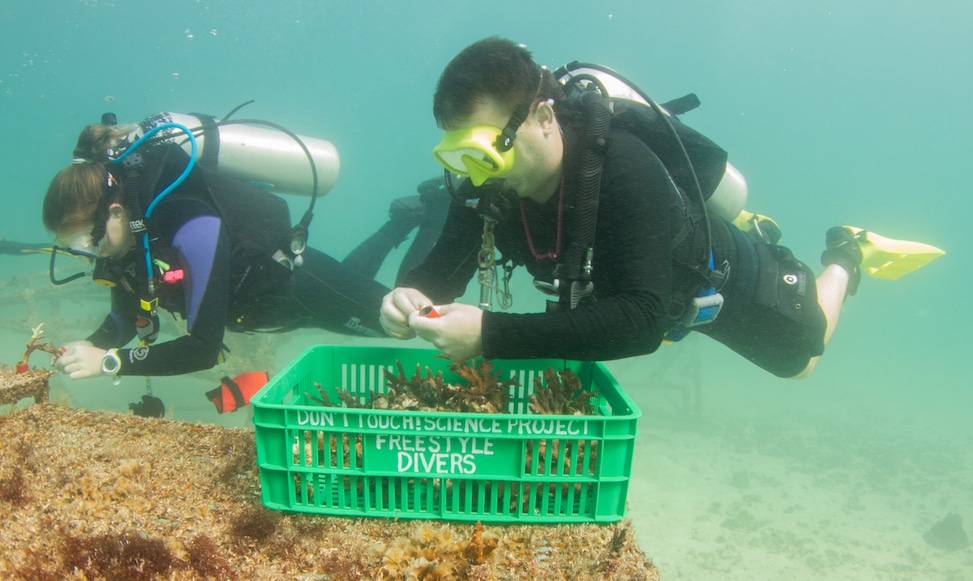
Introduction
I’d like to be
Under the sea
In an octopus’ garden
In the shade
We would shout
And swim about
The coral that lies
Beneath the waves.
Welcome to our second 2022 quarterly update for the Freestyle Divers coral propagation and artificial reef project. Our site is now affectionately known as Octopus Garden, inspired by the Beatles song and the new presence of an octopus that has made our artificial reef its home!
The site has flourished as we have come into the summer months, attracting several larger species such as Guitar sharks, Stingrays and Turtles. Its is thanks to our sponsors of the reefs that this project can move forward and like the site itself start to attract larger species. We now have over 25 structures installed plus four fully planted and maintained nursery tables, and many more structures are in the design and build phases for installation after the summer water temperatures start to drop. The Octopus Garden is taking shape and we have recruited and trained more volunteers to express their horticultural tendencies.
The analogy of a garden is very fitting, as gardeners do not grow plants, the plants grow themselves. The gardeners just make the conditions perfect for the plants to grow, just like we do for coral, we provide the setting and help them to do what they do best.
The reef structures you have sponsored are the garden trellises of this underwater project, the physical space thatcoral can grow on. The nursery tables are the greenhouses, but rather than tending to seedlings we tend to coral fragments, helping these “young” corals develop into larger, more resistant forms. In a terrestrial garden we have birds, slugs and other species that can harm the seedlings, in the ocean there are no birds, but there are parrot fish which can be somewhat heavy handed when they nibble at the coral. We do get snails and other invertebrates such as sponges and worms which can also harm the young corals. However, under the water we can’t just spray pesticides, so these need to be tended by hand. This process of maintaining the nursery tables is the core of our volunteer program, involving divers from all over the UAE who contribute to this project.
Why Artificial Reefs?
Artificial reefs are widely accepted as an effective form of marine resource management, taking the natural reef, and as an initiative of marine conservation identifying it as a resource with tangible value to the locality. This is a large step in the rehabilitation and restoration process of the irrefutably degraded state of the global reef ecosystems. Compounded by the bleaching event in the UAE last year, this underlines the need for human intervention, if we are to stand a chance of preserving these flourishing marine ecosystems.
What coral needs to grow
Coral and planula larvae need a solid porous substrate to grow on, which means that swathes of coastline that have perfect conditions for coral growth remain barren, as they only offer sandy substrate with nothing for coral to grow on. This constrains the growth of natural reefs to the limited number of rocky outcrops along the coast. The idea of an artificial reef is to provide a suitable substrate, a solid foundation to allow coral to grow and fulfill its role as an ecosystem architect. By providing this foundation in the form of artificial reefs, the coral can attach and grow, and the ecosystem will form.
Coral propagation as an accelerator
Our coral propagation efforts accelerate this process, firstly by providing the structures, then taking naturally broken “seedling” fragments from the ocean floor around natural reefs and nurturing them to a size that can be transplanted from our nursery tables onto permanent artificial reef structures. If you would like to discover more about this process, you can sign up for one of our face-to-face or online education briefing sessions, or even sign up for a course, these can be tailored to your needs.
It’s not just the large marine life that’s interesting, it’s the small creatures now present, which are playing vital roles and forming symbiotic relationships on the site, highlighting the complexity of interspecies relationships we normally find on coral reefs and are starting to see on Octopus Garden.
Interspecies relationships
To get started, let’s run through a recap of the relationships that different species can form with both the same species, as well as between different species.
Firstly, we have Parasitism, whereby one organism gains at the detriment of the other organism, it’s not something we want to see much of on the reef and fortunately we don’t. The next is Commensalism, whereby one species gains, and the other is unaffected; an example would be a remora which attaches itself to a shark. Lastly, we have a mutually beneficial symbiosis, which is a crucial part of life on the reef, whereby interspecies interactions create benefit for both species, forming the spectrum of harmonies which make the coral reef ecosystems so diverse.
Species focus: cleaners
The first species focus we will look at are the cleaners and their subject, both of which are present on Octopus’ Garden. The oceans are devoid of showers, toothbrushes, and cleaning products, at least hopefully, which begs the question: how do marine creatures clean themselves? Blue streak cleaner wrasse are the valets of the ocean; once they take up residence, they attract larger pelagic species which we are now observing on Octopus Garden. The receivers of the wrasse’s services will literally queue up for the cleaner wrasse, and once they get to the front of the queue, they will patiently wait for the wrasse to do their work. The large species will open their mouths and open the operculum (gill cover) and the wrasse will remove pieces of detritus and parasites. The wrasse gets a free meal, and the large species is cleaned, benefitting both individuals in a truly mutually beneficial symbiosis.
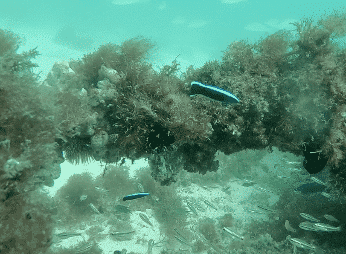
Species Focus – Carnivores: Moon Wrasse
The blue streak wrasse is not the only wrasse to be found on octopus garden we also have a healthy population of juvenile moon wrasse. These carnivores will play a vital role in controlling invertebrate populations, while also adding to the diversity of the Garden. These will in turn mature and migrate to the natural reef, and in future play a role in vertebrate and invertebrate predation over the wider artificial site. Wrasses are an interesting type of fish in that they swim using their pectoral fins, parrot fish are wrasses, flapping their wing like fins to move through the water. The caudal fin in some species of wrasse such as the broom tail wrasse ,commonly found in these waters, have evolved to have a sacrificial caudal (tail) fin as an anti-predation adaptation. It’s these predator prey interactions and adaptations which add to drive the diversity of the coral reefs.
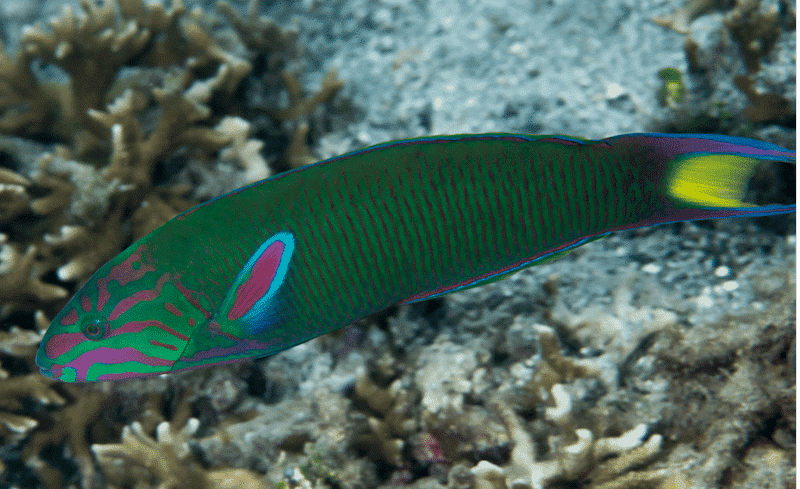
Species Focus – Omnivores: Lozenge File Fish
Lozenge file fish have taken up residency on the Octopus’ Garden as well. These little darlings are the most common response to the question “what’s the fish that kept nipping at my fingers whilst working on the propagation tables?” Annoying as they may be, they are a welcome presence on the Garden; as omnivores, they will feed on filamentous algae, macro algae, tunicates, sponges, coralline algae, and hydrozoans, promoting coral dominance and therefore growth. Relatives of trigger fishes the first dorsal fin is a single spine which acts as an anti-predation morphology but also signifies when the fish will exhibit some of its more aggressive tendencies.

Species Focus: Turtles
Green turtles are always a favourite for divers and they are now a common site on Octopus Garden. This is brilliant news, not only for photo opportunities, but also as they signify a healthy environment and play a crucial role in herbivory. Green turtles will feed on macroalgae around the reef and juveniles will also feed on sponges and jellyfish, which is far better than them feeding on plastic pollution, which is a serious threat to turtles globally. Existing since the time of the dinosaurs in the cretaceous period, these beautiful creatures are just one in a very long list of marine life threatened by our anthropogenic impacts and irresponsible actions.
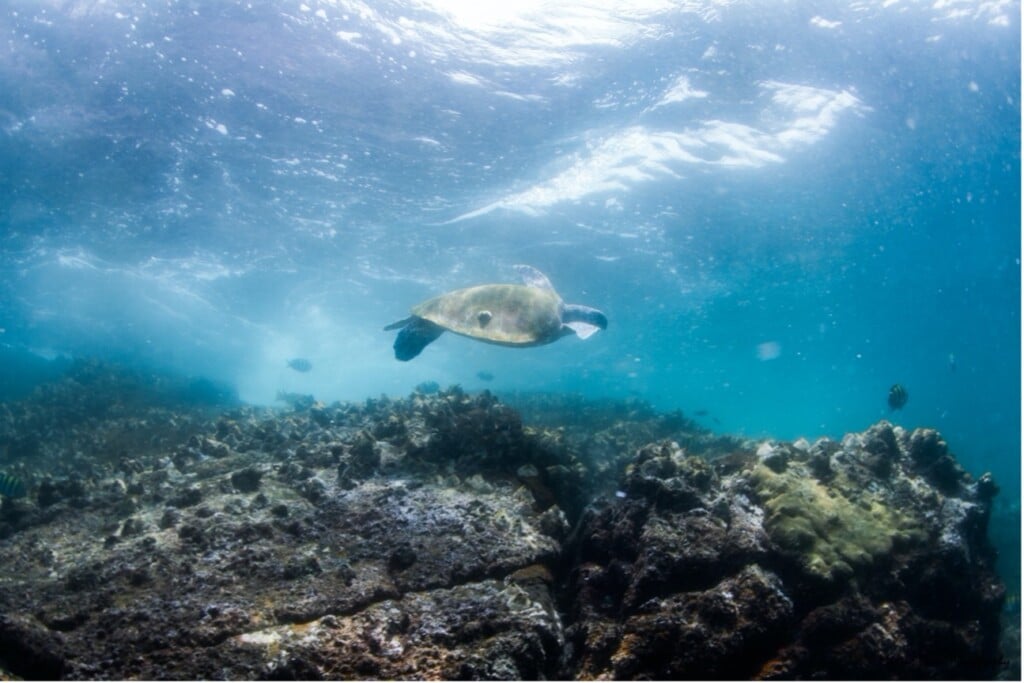
Species Focus: Rays
The Guitar shark, whilst technically a ray, has a distinct pointed head and shark-like posterior with a distinct dorsal and caudal fin which is the cause for mistaken identity and subsequent naming. We are super happy to welcome this species to Octopus Garden as these, like stingrays, are bottom feeders with a diet consisting of invertebrates such as molluscs and crustaceans. These fascinating creatures are a good indicator of sheltered habitat and the artificial reef’s development into the resemblance of a natural patch reef. Sharks, skates, and rays evolved before trees. However, we as race and a fellow inhabitant of this rock hurling through space are killing over 100 thousand sharks daily, including guitar sharks, for their fins so that a bland bowl of soup can be made.

Other rays have also been spotted on the reef, including the stingray, cow tail ray and the electric torpedo ray. All bottom feeders and relatively common, it’s stilll very nice to see them congregating around the Garden. The electric torpedo ray uses it caudal fin for propulsion rather than the usual pectoral method of standard rays and was once a creature of myth – folklore from fisherman spoke of a creature with the ability to shock and cause numbness without contact. The ray was once even used as a headache cure similar to the idea of shock therapy. In modern times,interestingly, the ray is still used for neurobiological research.
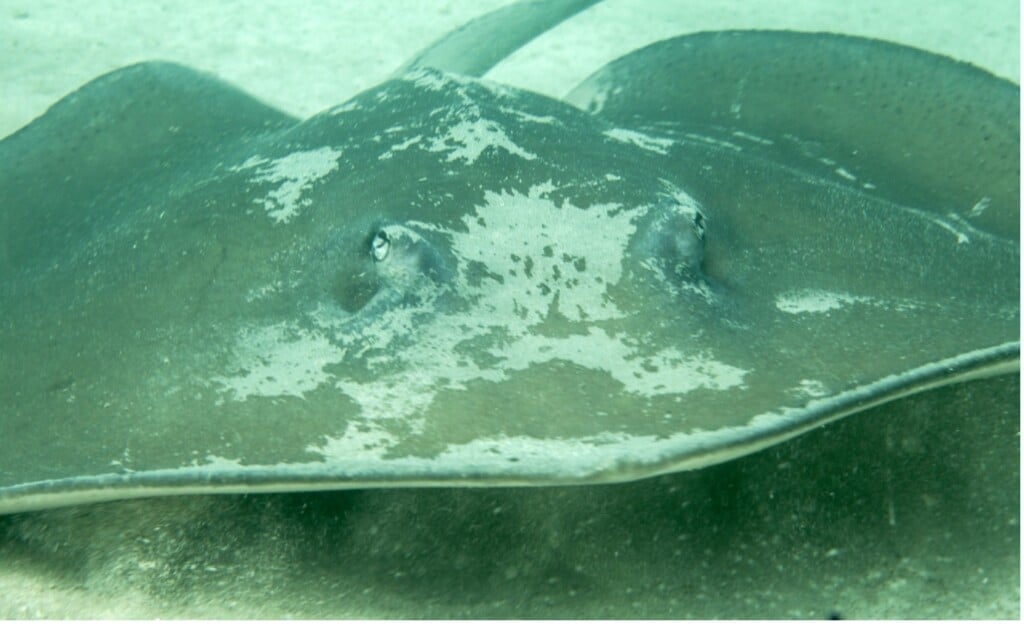
Species Focus: Octopus
The last species focus for this update is the Common Octopus – Octopus vulgaris – which is anything but vulgar and the presence of this intelligent invertebrate has led to the official renaming of the site from Freestyle reef to Octopus Garden. The Octopus, like the Cuttle fish, is a Mollusc of the class Cephalopoda and possess the ability to change its colour and texture as a form of camouflage and antipredation adaptation. Octopi do not have a brain per say, in fact the majority of their neurons are found in the tentacles, each with its own “mind”. A dismembered tentacle can continue to search for food, then try to bring it back towards the now missing mouth! Octopi have three hearts, 8 tentacles and can squeeze through holes the size of their beaks (yes octopi have beaks) so these are truly alien creatures of the oceans. The temporary resident octopus on the Garden is a female protecting her eggs for around 3-5 months and will eventually die after the last of the offspring hatch, as they rarely leave the brood during that period.

Coral as an ecosystem architect
Coral is the ecosystem architect of this project – we are providing the foundations through installation of our artificialstructures – but it’s the coral that creates the buildings: highly complex structures striving to have high surface areas to maximise production. Coral propagation could be utilised for all hard coral, however some corals only grow 3mm annually whereas others can grow up to 30cm in perfect conditions. To avoid waiting 10 years for 3cm of growth, we are currently focusing our efforts on the fast-growing corals such as Acropora species.
Fast-growing Coral Species
These corals can grow in a branching or plate structure, but they won’t grow in a massive structure. This means they will always have thin offshoots and are subsequently vulnerable to damage and breakage, creating the fragments we utilise in propagation. The branching morphologies are very beneficial to reefs, in that they create vast amounts of habitats that allow small marine life to call these structures home. Normally, when natural breakages occur through wave action, currents, or predation the fragments will fall into the web created by the complex branching morphologies and (if the parent stock is the same) it will reattach and continue growing. If however, these fragments find their way into sand or fall to a deeper part of the reef then the fragments will simply die – unless we do something about it.

Coral propagation on Octopus’ Garden
We collect these broken fragments from the seafloor around the natural reef, normally after storms or rough seas. We then take them to the propagation tables and secure healthy fragments onto the propagation tables using sections of hose. The rubber hose ensures that the coral can’t bind to the metal grid table surface, as its non-porous. This makes transplanting the larger fragments onto the artificial reefs or back onto damaged natural reefs much easier and reduces damage to the coral structures.
Focus coral species for the current project phase
The two coral species which are the current focus of the project are Acropora muricata and Pocillopora damicornis; these were selected due to their affinity as being the dominant species on shallow reefs in the area:
Acropora muricata is the dominant species further down the coast and since the bleaching event of Dibba Rock, this is the species repopulating Dibba Rock. A very common species, normally dominant on shallow reefs, it is branching and fast growing. This is a perfect coral to focus on when undertaking coral propagation on mid water nurseries and the acquisition of natural fragments from natural impacts means there is no need to create fragments. This is the main current focus of our project with regards to a species although we are notlimiting the selection scope in the future. Fragments are collected from multiple areas of the natural reef around Dibba Rock, ensuring genetic diversity is achieved.
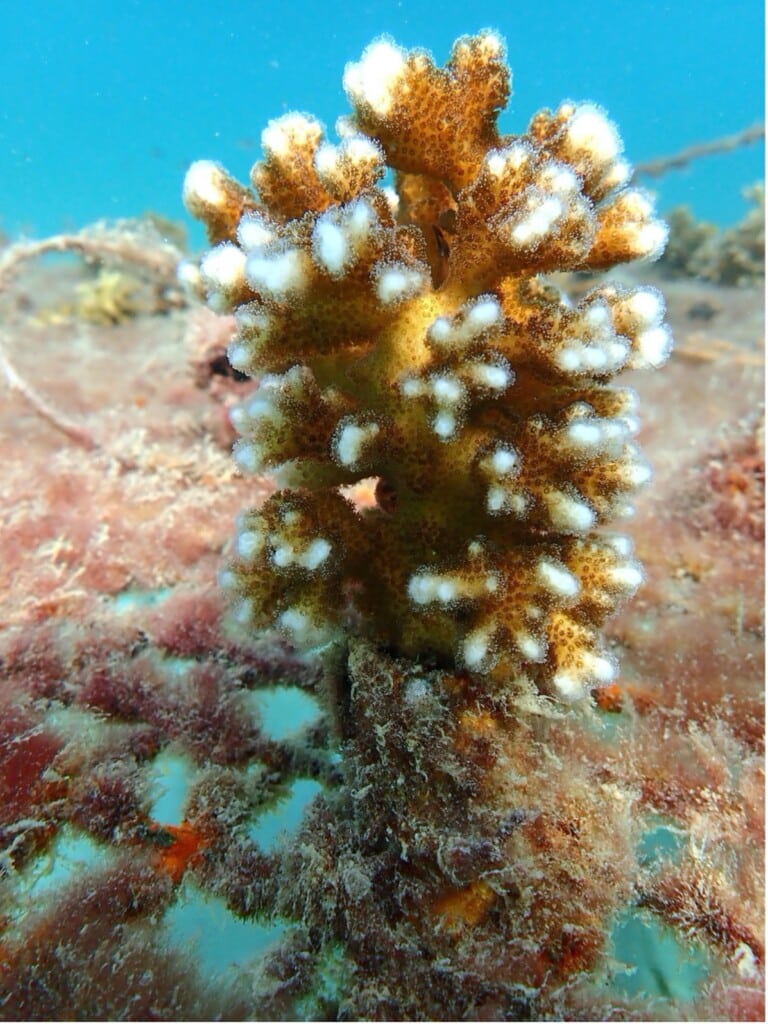
Pocillopora damicornis was the previous dominant species on Dibba Rock, but it was decimated during the summer of 2021 due to bleaching. Therefore, it is a minor focus of our propagation due to the potential fragility of the species with regards to increasing sea surface temperatures. Having this species will allow for evaluation and studies to be undertaken comparing temperature to bleaching.

Coral growth and survival rates
We undertook a study of the growth rates and survival rates for both the coral species. A table was sunk on the 19th of January 2022 and took the first data set on the 27th of January 2022. In total we planted 187 fragments on the table, 161 of those fragments were around the mean size of 5cm for A. muricata. and 6.6cm for P. damicornis. We then maintained the fragments of the table and took another data set 5 months later on June 28th.
The following table shows the mean coral fragment sizes of both A. muricata and P. damicornis. The number of fragments on the table at the initial planting was 187. The first 161 in the upper half of the table are the smaller mean fragments for both the species. The second half shows the results from larger fragments for both species.

Growth and survival rate discussion
The results show the successful growth of the corals with acceptable mortality rates. Mortality rates were due to several reasons, mainly displacement which was likely due to insecure placement but also potentially currents, marine life, or a combination of all of the above. A large problem, and a major reason for the mortality shown, was the presence of a white sponge which grows upwards from the base of the corals. The sponge is potentially a relative of Chalinula nematifera and is highly prevalent on the natural reef of Dibba rock, howeverfurther investigation is required. Attempts were made to remove the sponge, although total removal from the centre of a complex coral was very difficult. In situations where the coral had become overwhelmed, the now dead fragment and the sponge were removed from the table and buried to prevent further contamination on other corals. Of the studied corals P. damicornis had a higher mortality than A. muricata. A. muricata also had a higher growth rate than P. damicornis. These results highlight the correct decision as to which the coral focus species should be and correlates with the typical focus of mid water coral propagation efforts. Further investigation on a larger scale with more manpower and increased maintenance will undoubtedly impact results positively and the granting of a new and expanded permit would allow for this, now that we have the project methods fully stabilised and underway.
Reef Roundup
We finish this quarter’s report with a quick round up of some highlights from a selection of our kind reef sponsors – we are truly grateful for your support.
Firetti Contemporary
This turtle reef is doing very well and has settled nicely, it also became home to the octopus when she was protecting her eggs. Corals are planted on the top of the turtle and are thriving.
DITH MENA
Three nursery tables are all fully planted and maintained and are doing well. They resisted the recent bad weather and rough seas which shows that our new nursery table design is working. The Tribulus flower has been planted with coral, keeping in mind that we try to leave at least 50cm between corals to allow for growth and prevent future crowding. The small turtle and medium stingray have also been partially planted and coral has binded to the structures. The small turtle actually had nudibranch eggs on it temporarily. The large octopus is my personal favourite structure on the reef and has numerous large pieces of corals now planted and secured onto the structure. This structure and the presence of an octopus on the site lent to the name “Octopus Garden”.
Dell
The table is holding up brilliantly, despite some storm challenges over the last few months, and has three large pieces of coral planted, again allowing for space for future growth of the coral. This was also the site of an experiment to ensure coral can bind to oyster shells, which was a success and has provided us with various opportunities to use natural oyster shells from Dibba Bay Oysters as a substrate for future work.
Scotch & Soda
This reef structure has settled onto the site very well, it is yet to be planted with coral as we are waiting to acquire more large fragments or for fragments to grow sufficiently on the propagation tables. The structure is holding up very well. We have observed a couple of nudibranch individuals not normally seen on Dibba Rock; however these ones are heavily camouflaged and therefore easy to miss for fun divers. Groupers and eels are also commonly seen around the base of this structure.
Upfill.
The Upfill. reef table has three large corals planted, allowing room for future growth, the structure is holding up very well. This is often the site where the guitarshark can be found buried in the sand underneath the table.
IDS
The nursery table is fully planted and coming along nicely, and this is actually the table we are performing the research and data collection from. It has been adopted somewhat by a father-daughter pair of volunteers who initially planted the table and are performing the ongoing maintenance when they come. Her involvement in the project was used as part of a Duke of Edinburgh award scheme for her school.
Ounass
Three tables are now home to a school of longfin batfish. Yet to be planted with corals, as we are waiting to find more larger pieces or for the corals on the tables to grow sufficiently. One of the tables did get damaged during bad weather in June, however it has since been repaired.
Guinness Book of Records Dome Reef
The dome is doing well with three pieces of coral now planted on it. Commonly found to have groupers, eels, or goat fish around the base of the structure, given it’s mimicry of the low, ‘rocky outcrop shelter’ type of feel, similar to natural formations typically seen at Dibba Rock.
Maersk Turtle
The structure has settled very well and is now home to a range of marine life. Coral has been planted on the top of the structure which is proving successful thus far. We have seen a pair of butterfly fish residing around this structure.
X-press Feeders
The whale shark design is holding up nicely. It’s been partially planted, we are waiting for some larger pieces of corals to develop it further. We did spot a juvenile Arabian angelfish swimming around this structure which was great to see. Commonly acquired for appearing in tanks because of their beautiful colouration, these fish are usually very timid and are prone to stress easily – at this point they aren’t even seen often on Dibba Rock. It’s presence suggests we are succeeding in providing a stable, comfortable environment for further development.
Mandarin Oriental
One of the most recent structures sunk. It is bedding in nicely and we are waiting for larger pieces of coral to grow before transplanting them onto this reef.
Summary
Overall, the structures are doing well and developing nicely into a sustainable ecosystem flourishing with life. Although we’ve already highlighted some key species found in specific areas, every structure is already home to an array of life including (but not limited to) crabs, cardinal fish, gobies, and blennies. With our growing pool of volunteers, we are making good progress and can only get better. A big thank you again to everyone involved in the support we’ve had so far; we couldn’t do this without you. We’ll keep you posted with our next update!


